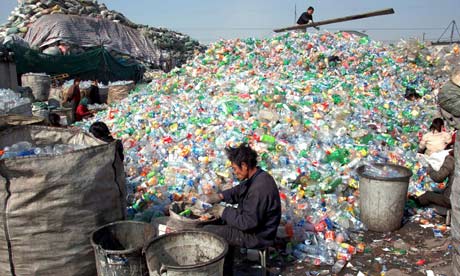 |
| From the National Assn. for PET Container Resources http://www.napcor.com |
We are recycling more. And more. And more.
In the U.S., from 1999 to 2009 we nearly doubled the tonnage of #1 PET plastic we recycled. Almost none of that extra wonderful, "easy-to-recycle" PET stayed in the U.S. 91% of that extra plastic we dutifully recycled was dumped on developing nations, mostly China. The reason is simple. Recycling plastic into safe, strong, useful materials -- while protecting the health of workers & local communities -- is extremely hard, expensive, and rare.
- Plastic needs to be sorted extremely finely. One stray #3 plastic bottle can contaminate a batch of 10,000 #1 bottles if melted with them, leaving a product filled with yellowed or black streaks.
- Plastic can't be superheated to kill toxins. Instead, recyclers use acids, caustic soda, and chemical slurries to burn off contaminants. The waste is toxic, persistent, and expensive to mitigate.
- Bottlers change designs too quickly for recycling technology to keep up. Coke learned this with the epic flame-out of its $50 million bottle-to-bottle recycling facility in South Carolina. That facility couldn't cope with one design change -- a thinner bottle -- and imploded.
Sell it to China.
Why would China buy 553,000 metric tons a month of Western plastic waste that nobody wants? Simple. In the U.S. we have a regulatory system that functions. Not perfectly, but it functions. In China, for all intents and purposes, they don't. Even in areas where regulation exists, the cost of fines is less than the cost of compliance. The result is a no-brainer. Recycling plastic in the U.S. is expensive. In China, it's cheap.
11 provinces in China are recognized as major plastic recycling centers: Hebei, Shanghai, Guangdong, Zhejiang, Beijing, Jiangsu, Shandong, Fujian, Henan, Liaoning, and Anhui. The heart of recycling in these provinces are self-described "recycling villages." Places where plastics aren't just a job, they're a way of life.
Here's a little trip through a few Chinese recycling villages. Getting photographs & stories like this isn't easy, and is getting harder as the world takes a closer look. City managers and mayors work to keep Western cameras out of their villages, sometimes threatening -- and using -- violence.
Zhaoqing, Guangdong Province (the nearest province to Hong Kong, and thus one of the largest and busiest recycling centers):
 |
| Original photo by D J Clark, found at: http://www.flickr.com/photos/99425225@N00/1558890678 |
Fuyang, Anhui Province. A worker stands in toxic rainwater, pulling batteries from plastic trash, separating out the plastic and batteries for recycling.
 |
| Original photo by pots455, found at: http://www.flickr.com/photos/pots/456442389 |
Ma'anshan, Anhui Province. Untreated wastewater from plastic processing plants dumps straight into the Yangtze River.
 |
| This and other photos at: http://www.chinahush.com/ 2009/10/21/amazing-pictures-pollution-in-china/ |
Wenan County, Hebei Province. A huge importer of Western plastic. This picture is one of countless open-air recycling centers in the county.
 |
| Photo and story can be found at: http://www.ecns.cn/in-depth/2011/07-05/444.shtml |
In Wenan, groundwater down to 100 meters is now polluted and undrinkable. Young people no longer pass the army's physical, as they have enlarged livers. The county's sewage treatment plant doesn't operate. That's right: The one sewage treatment plant for 10,000 plastic recycling workshops is only turned on when government officials come by.
The plastic that can't find any reuse often gets a simpler end: an open pit bonfire, spewing black toxic clouds into the air. Such as here, at Guiyu, Guangdong Province, center for plastic and especially e-waste recycling:
 |
| This and other brilliant photos at: http://www.alexhoffordphotography.com/node/2206 |
Here's a river in Guiyu, Guangdong Province:
 |
| Story & photo by Greenpeace: http://www.greenpeace.org/ international/en/multimedia/photos/polluted-water/ |
And it's not just China. Here's a snapshot of another place that collects & processes Western plastics, Khoai, Vietnam:
 |
| story & photo at http://vninfogate.com/gate/?module= newsdetail&newscode=7685 |
As of now, more than 50% of the plastic we in the U.S. recycle goes to these nations. Where so much of the sorting, remelting, and processing happens under these conditions. This is what plastic recycling really is. This is why plastic recycling is cheap, why we can buy so much cheap plastic garbage in the $1 aisle of big-box stores.
It's sobering to think that one out of every two soda / juice / water bottles each of us puts in our neat, tidy bin is directly responsible for the scenes above. Plastic recycling, 2011 style: Not green. The farthest thing from green.
 |
| The Triangle Is a Lie |
Whoa, this is pretty surprising. You have to wonder why there is still an abundance of plastic wastes despite the efforts of governments to manage and recycle them. Extensive recycling programs should be implemented to avoid situations like this in the future.
ReplyDeleteAnother great post!
ReplyDeleteBring on refillable glass, and reusable packaging, it's the only logical solution for packaged goods. Have a global design standard so empties can be refilled and reused wherever they are consumed.
Refillable glass has a lower carbon footprint than PET or aluminium, is 100% recyclable and uses fewer resources and energy.